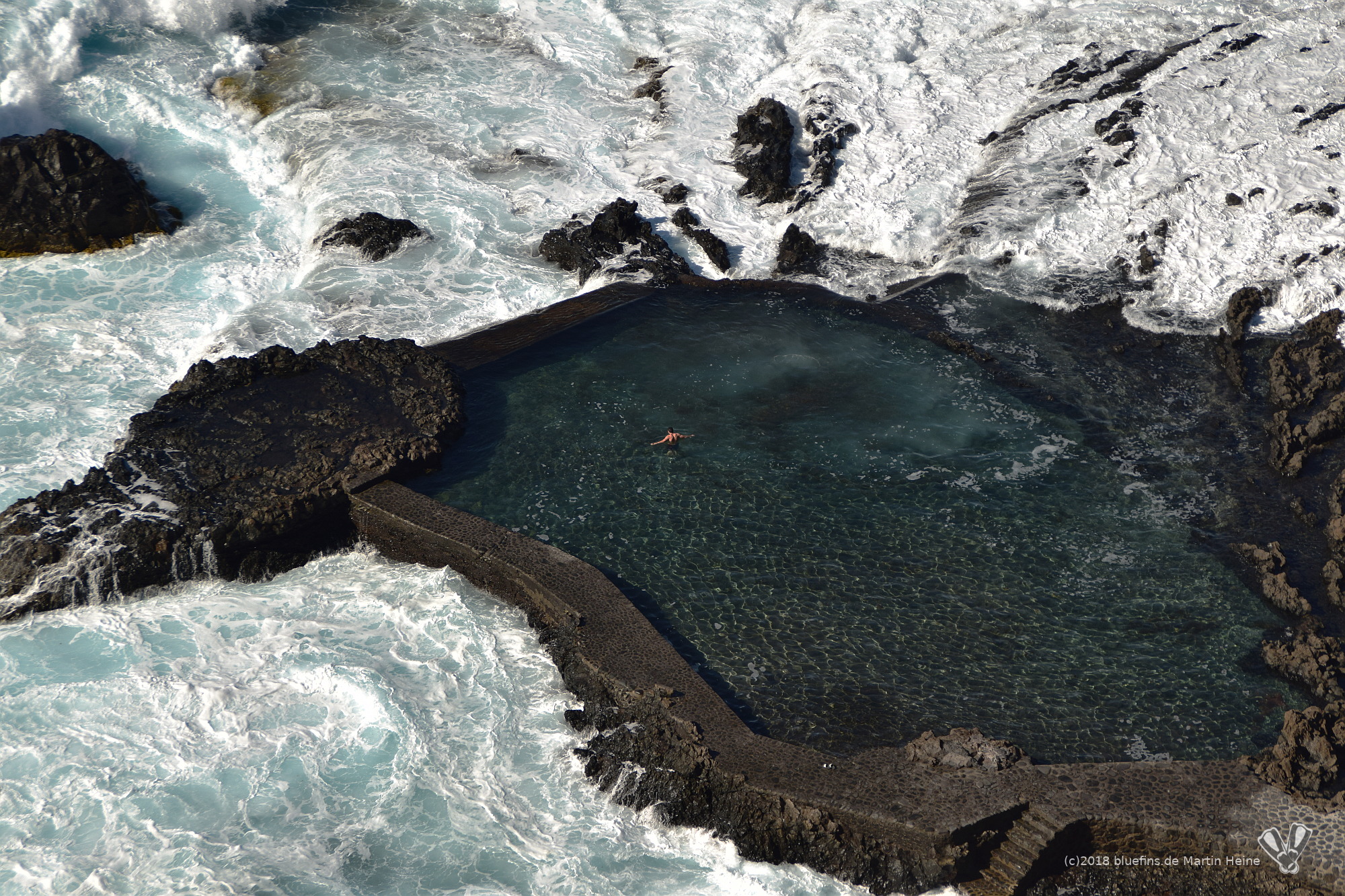On one of those rainy days, gray clouds almost touching our flat roof top, we were dreaming about hot tropical islands. This is usually the moment, where my fingers magically move over the keyboard of my computer, typing keywords into Google like: “vacation”, “hot and sunny”, “art”, “nature” a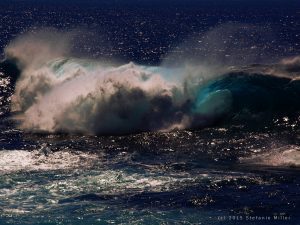 nd “diving paradise”. Guess what popped up next to Hawaii and the Caribics? “El Hierro!”
nd “diving paradise”. Guess what popped up next to Hawaii and the Caribics? “El Hierro!”
El Hierro is the smallest, most south west island in the Canaries. But not only this, it is also the most south west peace of land of Europe. This little island was known in European history as the prime meridian in common use outside of the future British Empire. Before Christopher Columbus’s great journey, he first sailed to the Canary Islands in the Atlantic Ocean off the coast of Africa, which were ruled by the Crown of Castile, where he restocked provisions and made repairs. While securing provisions from the island of La Gomera, Columbus received word that three Portuguese caravels had been seen hovering near the island of El Hierro with the supposed intention of capturing him. However, on September 6, 1492 the westward voyage began without incident. On h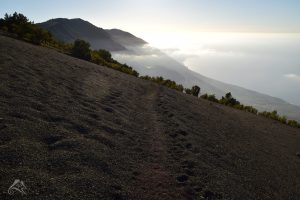 is second transatlantic voyage, Columbus stopped in El Hierro for 17 days in 1493, before setting out.
is second transatlantic voyage, Columbus stopped in El Hierro for 17 days in 1493, before setting out.
As more as I was reading online about the mystic Bimbache, Volcano eruptions and the spirits of nature above- and below the surface of the ocean, the more I got intrigued. Wikipedia tells: “Each island of the Canaries had its own gods, distinct to each island, though the islands shared common concepts in their mythology, such as divine power represented by Nature. The two benign deities in El Hierro were the god, Eraorahan, and the 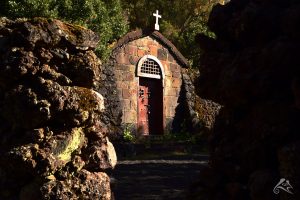 goddess Moneiba, with a third malevolent god, Aranfaybo who was prayed to in times of desperation…” Native religion’s symbols of nature still can be found all over the island. The people of El Hierro today believe in being one with nature. This most remote of Spain’s Canary Islands, is now billing itself as the world’s first energy self-sufficient island that has never been hooked up to a power grid.
goddess Moneiba, with a third malevolent god, Aranfaybo who was prayed to in times of desperation…” Native religion’s symbols of nature still can be found all over the island. The people of El Hierro today believe in being one with nature. This most remote of Spain’s Canary Islands, is now billing itself as the world’s first energy self-sufficient island that has never been hooked up to a power grid.
“Lets go there” I said, and immediately looked for flights. But there were no Flights. The Airport of El Hierro is that small, that only a local airline called Binter, serves as a regional carrier operating inter-island services within the Canary Islands. The closest International Airport is located in Tenerife. There are two ferry connections from Los Christianos, Tenerife to Valverde, El Hierro. So the probably most convenient way to travel to El 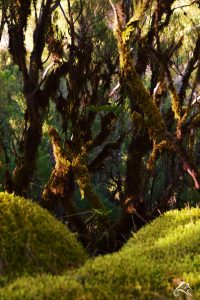 Hierro is to book a flight to Tenerife and book a rental car to pick up at the Airport to take on one of the car-ferries. Thats exactly what I did, while my Girlfriend was e-Mailing with an El Hierro diving center she found in one of her online diving forums.
Hierro is to book a flight to Tenerife and book a rental car to pick up at the Airport to take on one of the car-ferries. Thats exactly what I did, while my Girlfriend was e-Mailing with an El Hierro diving center she found in one of her online diving forums.
The exciting journey began at a little beer garden outside the waiting area of Airport Memmingen, Bavaria, South Germany. A couple of hours later, we were picking up the little Hyundai car at the Tenerife Airport. I attached my Navigation Device I brought with me, to the front window and followed the given direction to Los Christianos. After a short stop at a Spanish Grocery store to pick up a bottle of good Spanish wine, we arrived in front of a huge ship at the harbor. A guide in a orange veste was welcoming u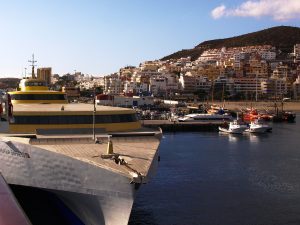 s with the question: “El Hierro?” and directed us to lane 4. After a short walk to the nearby office to buy the ticket, we parked the car inside the big stomach of the futuristic looking Fred Olsen ferry. Wow, this was easy again.
s with the question: “El Hierro?” and directed us to lane 4. After a short walk to the nearby office to buy the ticket, we parked the car inside the big stomach of the futuristic looking Fred Olsen ferry. Wow, this was easy again.
When we left the ship, it was already night. A very steep and tiny street with many steep and tiny curves greeted us for our arrival. El Hierro is a 1500 Meter rock in the Atlantic Ocean. And to get from one side of the island to the other, you always have to climb that rock. So if a village is 15 km (10 Miles) away, It takes you an hour to get there. La Restinga has about 500 inhabitants and mainly lives from fishing and diving. Like on most of my artistic journeys, it ends up at somewhere in nowhere, in the middle of some dark street at midnight, no sign of any hotel or friendly apartment nowhere. We called the apartment owner. Gladly she didn’t sleep yet, or maybe the did, and woke up. “Don’t move” she said. We are coming…
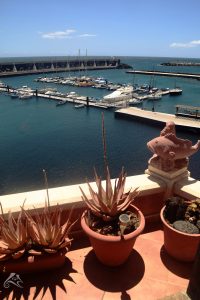 Next morning we woke up in an apartment, which couldn’t be more nice. It had two bedrooms, a kitchen, a little living area and the most spectacular panorama window I have ever seen. The Building was on top of a lava rock, overlooking the entire harbor with all the yachts, sailors and fishing boats while the village nestled beautifully between the volcanic formations, floating all the way down to the water. The first thought that came to my mind: I am in paradise.
Next morning we woke up in an apartment, which couldn’t be more nice. It had two bedrooms, a kitchen, a little living area and the most spectacular panorama window I have ever seen. The Building was on top of a lava rock, overlooking the entire harbor with all the yachts, sailors and fishing boats while the village nestled beautifully between the volcanic formations, floating all the way down to the water. The first thought that came to my mind: I am in paradise.
The following days we spend walking in the foggy forests, hiking on top of old volcano craters and rock formations. Every second day, my Girlfriend was diving while I used the time for creating sketches with pencil on paper. Sometimes, I use those sketches as pre-renderings for acrylic paintings. Many of those sketches got framed and sold.
Close to the ocean beach of El Hierro, it feels like being in a desert, surrounded by black and red lava stones of a living volcano, frozen in time. A few meters up hill, a beautiful pine forest emerges out of 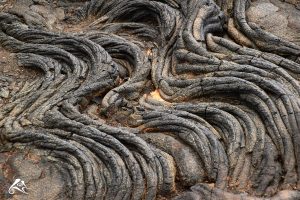 nothing. Later, it feels like being beamed into some foggy cold forest near London by Scotty of the Enterprise. Everything is wet and old trees, covered with moss plants appear in the mist until surrealistic ashes fields and lava stones appear above the clouds below a deep blue horizon.
nothing. Later, it feels like being beamed into some foggy cold forest near London by Scotty of the Enterprise. Everything is wet and old trees, covered with moss plants appear in the mist until surrealistic ashes fields and lava stones appear above the clouds below a deep blue horizon.
The origins of the island date back some 100 million years when the ocean floor shifted with the movement of the earth’s mantle. The crust consequently cracked into a three pointed star releasing flows of magma. After three successive eruptions, and consequent accumulations, the island emerged from the ocean as an imposing triangular pyramid crowned by a volcano more than 2,000 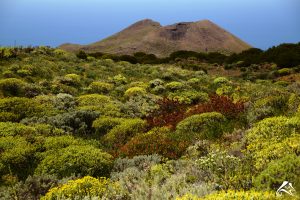 metres high. The initial crevices became channels for further lava flows which grew into three mountain ridges topped by numerous volcanic cones. While the magma cooled in these channels, it solidified into gigantic vertical basalt dykes, typical of the geological architecture of El Hierro. Even today, El Hierro volcanic activity is not all distinguished. In October 2011, after some dramatic seismic rumbles, a ocean water fountain shot up close to the coast of La Restinga. People were evacuated and diving was prohibited. It was dramatic, Günther said. He was worried that this was the end of his diving business. Most sea animals and ocean flora died. The underwater eruptions lasted until March 2012. But a year later, all new life developed on the dead ocean ground, and some creatures appeared, which had not been seen before.
metres high. The initial crevices became channels for further lava flows which grew into three mountain ridges topped by numerous volcanic cones. While the magma cooled in these channels, it solidified into gigantic vertical basalt dykes, typical of the geological architecture of El Hierro. Even today, El Hierro volcanic activity is not all distinguished. In October 2011, after some dramatic seismic rumbles, a ocean water fountain shot up close to the coast of La Restinga. People were evacuated and diving was prohibited. It was dramatic, Günther said. He was worried that this was the end of his diving business. Most sea animals and ocean flora died. The underwater eruptions lasted until March 2012. But a year later, all new life developed on the dead ocean ground, and some creatures appeared, which had not been seen before.
On January 22, 2000, UNESCO declared the island of El Hierro Biosphere Reserve, which identifies the island as a model of how we should live with nature.
Places to visit
Faro de Orchilla
Ptolemy considered that the „Zero Meridian“ passed through the western end of the island, the „End of the Ancient World“ at the Orchilla lighthouse. Later, the French too were to establish the Prime meridian at Orchilla in 1634. In 1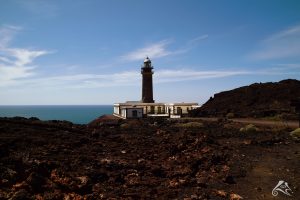 924 using stone brought from the municipality of Arucas on Gran Canaria, the construction of the lighthouse was initiated. It was built on the imaginary line that represented the Prime Meridian, in the style of the time. Three buildings form the lighthouse complex: the water tank, the lighthouse keeper’s house and the lighthouse itself. The work was completed in 1930. Close to the lighthouse, there are old ruins, build with volcano stones. A little lava cave can also be discovered. Unfortunately, the lighthouse is not open to the public. But in the Tourist Information Office in Valverde, for a little charge, it’s possible to get a special certificate confirming your visit at the meridian „0“.
924 using stone brought from the municipality of Arucas on Gran Canaria, the construction of the lighthouse was initiated. It was built on the imaginary line that represented the Prime Meridian, in the style of the time. Three buildings form the lighthouse complex: the water tank, the lighthouse keeper’s house and the lighthouse itself. The work was completed in 1930. Close to the lighthouse, there are old ruins, build with volcano stones. A little lava cave can also be discovered. Unfortunately, the lighthouse is not open to the public. But in the Tourist Information Office in Valverde, for a little charge, it’s possible to get a special certificate confirming your visit at the meridian „0“.
Garoe. The Holy Tree
This tree has been the source of many legends of the islands in the Canary Archipelago, showing the capacity of the inhabitants to take advantage of the scarce resources offered by the island. The Garoé is
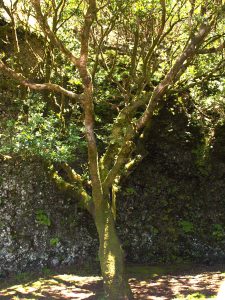 the sacred (Arbol Santo) of the natives (Bimbaches) and symbol of the Canary Island of El Hierro. The coat of arms of El Hierro showing a tree with clouds in his crown. The Garoé condensed water from the trade winds that seems „well“ of the tree itself. There is an interpretation center where you can get a good understanding of this phenomenon. For a little charge, it’s possible to get a special certificate confirming your visit.
the sacred (Arbol Santo) of the natives (Bimbaches) and symbol of the Canary Island of El Hierro. The coat of arms of El Hierro showing a tree with clouds in his crown. The Garoé condensed water from the trade winds that seems „well“ of the tree itself. There is an interpretation center where you can get a good understanding of this phenomenon. For a little charge, it’s possible to get a special certificate confirming your visit.
Valverde
Valverde serves as the island’s official capital. It is both the smallest Canarian capital and the only one not located by the sea. The town’s airport and seaport are both several kilometres away on the island’s 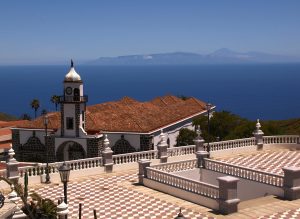 east coast. In the center of Valverde thrones the beautiful Church of Nuestra Señora de la Concepción from the 18th Century. Here, the festival of the descent of the Virgen de los Reyes is held the first Saturday of July every four years. The Town Hall with its interesting facade is located right next to the church. In valverde, there is also the Ethnographic Museum „Casa de las Quinteras“ with exhibitions on traditional craftsmanship of the island. You might want to shop at the craft shops, which are connected to the museum.
east coast. In the center of Valverde thrones the beautiful Church of Nuestra Señora de la Concepción from the 18th Century. Here, the festival of the descent of the Virgen de los Reyes is held the first Saturday of July every four years. The Town Hall with its interesting facade is located right next to the church. In valverde, there is also the Ethnographic Museum „Casa de las Quinteras“ with exhibitions on traditional craftsmanship of the island. You might want to shop at the craft shops, which are connected to the museum.
Lagartario – Centro de Recuperación del Lagarto Gigante del Hierro
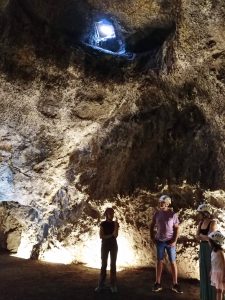 Roque Chico de Salmor Lizards are giant lizards, found on El Hierro. Unfortunately, they have been collected for museum specimens after its description by Steindachner in 1889, but none have been found later than about 1940. Following this population’s disappearance, the species was believed to be entirely extinct until Gallotia simonyi machadoi was discovered on the nearby island of El Hierro in 1974. The El Hierro Giant Lizard was successfully reintroduced to the Roque Chico de Salmor in 1999, but these lizards are the recently discovered subspecies Gallotia simonyi machadoi.
Roque Chico de Salmor Lizards are giant lizards, found on El Hierro. Unfortunately, they have been collected for museum specimens after its description by Steindachner in 1889, but none have been found later than about 1940. Following this population’s disappearance, the species was believed to be entirely extinct until Gallotia simonyi machadoi was discovered on the nearby island of El Hierro in 1974. The El Hierro Giant Lizard was successfully reintroduced to the Roque Chico de Salmor in 1999, but these lizards are the recently discovered subspecies Gallotia simonyi machadoi.
The Lagartario and the Museum Village Guinea are right next to each other. The entrance fee is valid for both. Guided tours are included.
Eco-Museum Village de Guinea
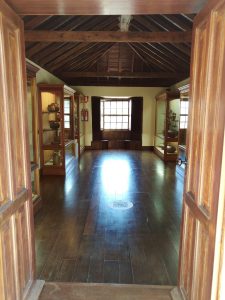 The village, now an Eco Museum lies in the Valle de Golfo at the foot of an overbearing cliff Guinea and is the third village claiming to be island’s oldest settlements. Its old houses have been restored and form the first eco-museum in Spain. The village hewn from the volcanic rock that surrounds it; so seamlessly integrated with its surroundings that landscape and village blend into one at various points.
The village, now an Eco Museum lies in the Valle de Golfo at the foot of an overbearing cliff Guinea and is the third village claiming to be island’s oldest settlements. Its old houses have been restored and form the first eco-museum in Spain. The village hewn from the volcanic rock that surrounds it; so seamlessly integrated with its surroundings that landscape and village blend into one at various points.
The eco-museum’s guided route show where and how the original settlers lived and how houses and household goods have evolved from the times of the Conquest through to the XXth century. The Museum Village Guinea and the Lagartario are right next to each other. The entrance fee is valid for both. Guided tours are included.
Pozo de las Calcosas
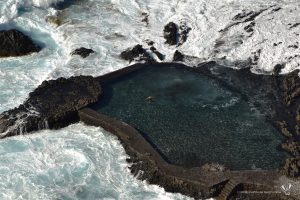 Pozo de las Calcosas is an interesting vacation village offering a natural sea water swimming pool, surrounded by lava stones, where the ocean waves break into a huge snow white carpet of bubbling spray. The village is accessible only by foot about 10 minutes steep downhill. (Don’t forget you have to get back up again). The very small houses are build with shaped lava stones. Some restored from old ruins with roofs made of straw. This place looks surreal.
Pozo de las Calcosas is an interesting vacation village offering a natural sea water swimming pool, surrounded by lava stones, where the ocean waves break into a huge snow white carpet of bubbling spray. The village is accessible only by foot about 10 minutes steep downhill. (Don’t forget you have to get back up again). The very small houses are build with shaped lava stones. Some restored from old ruins with roofs made of straw. This place looks surreal.
Hotel Punta Grande
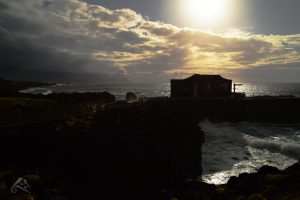 Both as a restaurant and later as a hotel, the house of Puntagrande has received several important national and international prizes, including the Guinness world record for the smallest hotel in the world, awarded in 1989. With its dramatic natural surroundings, architectural heritage and museum-like interiors which include an impressive collection of nautical registration plates, Puntagrande is regularly featured in international travel and architecture magazines. The hotel continues to attract curious, adventurous and discerning travellers from around the globe.
Both as a restaurant and later as a hotel, the house of Puntagrande has received several important national and international prizes, including the Guinness world record for the smallest hotel in the world, awarded in 1989. With its dramatic natural surroundings, architectural heritage and museum-like interiors which include an impressive collection of nautical registration plates, Puntagrande is regularly featured in international travel and architecture magazines. The hotel continues to attract curious, adventurous and discerning travellers from around the globe.
La Caleta
La Caleta is a small seaside village northeast of the island close to Valverde. In the past, the place served as an alternative pier at Puerto de la Estaca. When La Caleta’s fishing tradition disappeared, the village became mainly a vacation destiny and core of second homes. A cool lavastone seawater swimming pool architecture finalizes the beauty of the rocky beach. Like at many places of El Hierro’s lava rocks, ancient bimbache carvings had been found near La Caleta.
El Sabinar
 The juniper trees in the west of the island are a very unique. Their twisted shapes have been formed over centuries by the force of the wind and the climatic conditions. Sabinar (saving juniper woods) it is one of the areas provided with special environmental protection since 1975.
The juniper trees in the west of the island are a very unique. Their twisted shapes have been formed over centuries by the force of the wind and the climatic conditions. Sabinar (saving juniper woods) it is one of the areas provided with special environmental protection since 1975.
Cultural Interpretation Centre Park El Julian
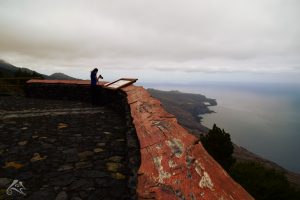 The El Julán Interpretation Centre is an archaeological site and museum. It was build by the Government of the Canary Islands after proposed by UNESCO for Humankind Heritage. El Julán Interpretation Centre is one of the most valuable and EXTENSIVE archaeological sites on the islands. The center offers an exhibition space plus an audiovisual Bimbache center with videos of the people and the history of the island. In the archaeological site itself, you can see the Tagoror (meeting place) and a long tongue of lava full of stone engravings, known as „The Signs“. These symbols have not been deciphered yet. In the caves, there had been discoveries of burials, mummified corpses and votive offerings such as domestic utensils and primitive tools. A snack bar on a terrasse invites for drinks and small beverages.
The El Julán Interpretation Centre is an archaeological site and museum. It was build by the Government of the Canary Islands after proposed by UNESCO for Humankind Heritage. El Julán Interpretation Centre is one of the most valuable and EXTENSIVE archaeological sites on the islands. The center offers an exhibition space plus an audiovisual Bimbache center with videos of the people and the history of the island. In the archaeological site itself, you can see the Tagoror (meeting place) and a long tongue of lava full of stone engravings, known as „The Signs“. These symbols have not been deciphered yet. In the caves, there had been discoveries of burials, mummified corpses and votive offerings such as domestic utensils and primitive tools. A snack bar on a terrasse invites for drinks and small beverages.
Diving Paradise La Restinga
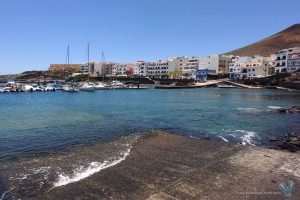 La Restinga is not the most overcrowded touristic place in the world. The vew visitors coming back every year are already known by the less than 500 inhabitants. The ones who are new, are more than welcomed with a warm “hola” and “como estas”. The village is located at the very south tip of the island, right in the middle of El Hierro diving paradise. There are about three of four fantastic restaurants, where the freshest tuna ever is being enjoyed. Some still wearing the wet diving suit while dining.
La Restinga is not the most overcrowded touristic place in the world. The vew visitors coming back every year are already known by the less than 500 inhabitants. The ones who are new, are more than welcomed with a warm “hola” and “como estas”. The village is located at the very south tip of the island, right in the middle of El Hierro diving paradise. There are about three of four fantastic restaurants, where the freshest tuna ever is being enjoyed. Some still wearing the wet diving suit while dining.
El Mirador de La Peña
Declared of C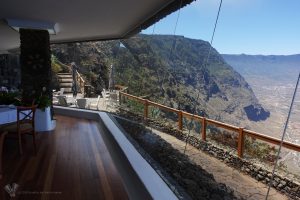 ultural Interest by the Canarian Government, this place has overwhelming views across the valley of the Gulf. There is an interesting restaurant lookout designed by the famous Lanzarote Artist Cesar Manrique, where you can enjoy the local cuisine as well as international dining. Never forget to visit.
ultural Interest by the Canarian Government, this place has overwhelming views across the valley of the Gulf. There is an interesting restaurant lookout designed by the famous Lanzarote Artist Cesar Manrique, where you can enjoy the local cuisine as well as international dining. Never forget to visit.
Hiking in the Misty Forest
A really beautiful impression about the nature of El Hierro is a walk in the Misty Forest. Several Trails are very well made, with way signs you can’t miss. 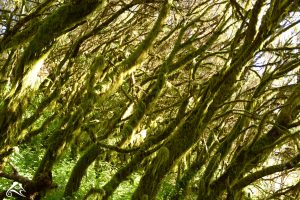
Links and Contacts
El Hierro official Website
http://www.turismodecanarias.com/canary-islands-spain/tourism-office/el-hierro-island/
Ferry and Airfares
http://www.fredolsen.es/en/destinations/el-hierro
http://www.navieraarmas.com/en/home
https://www.bintercanarias.com/eng
Diving

